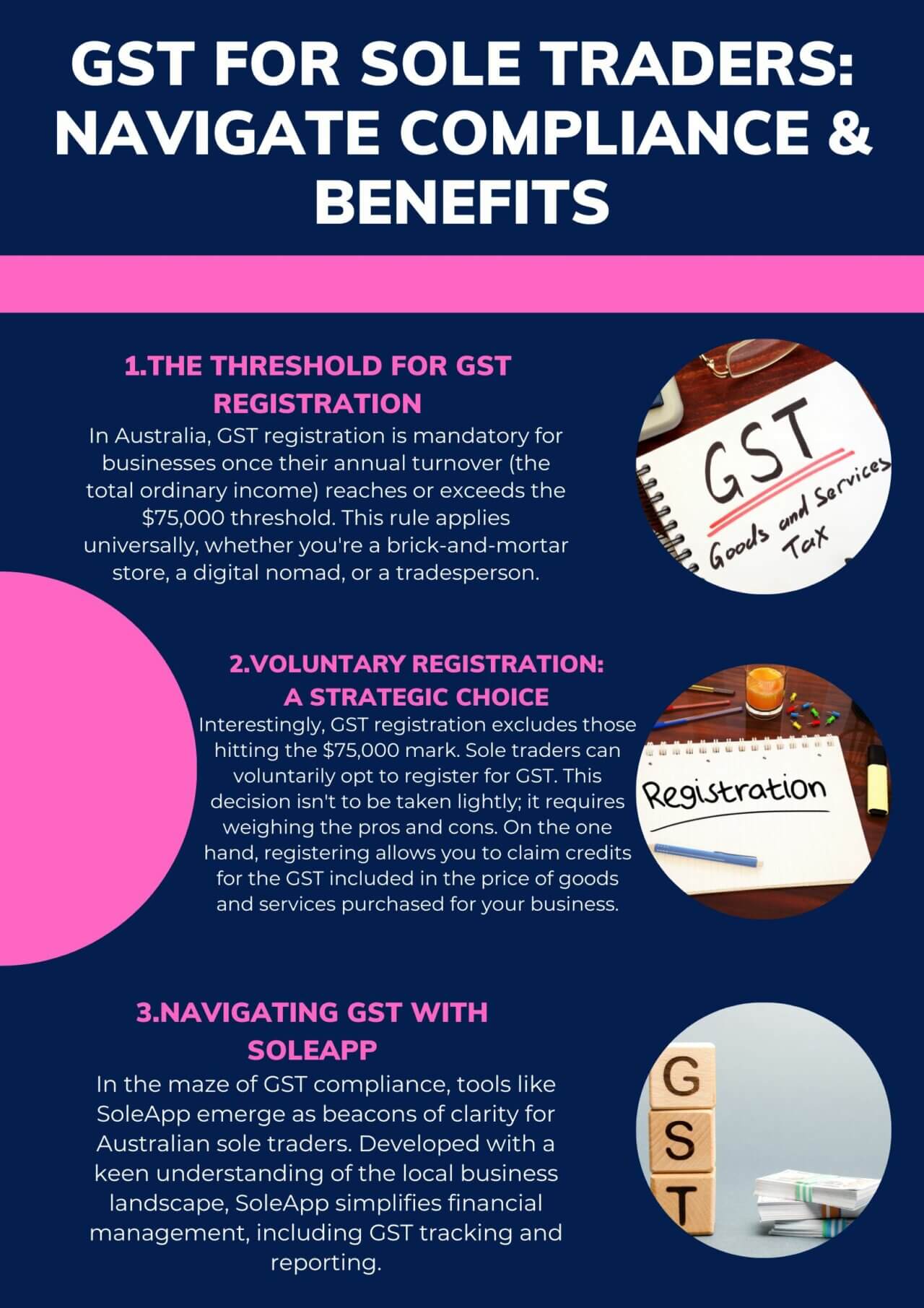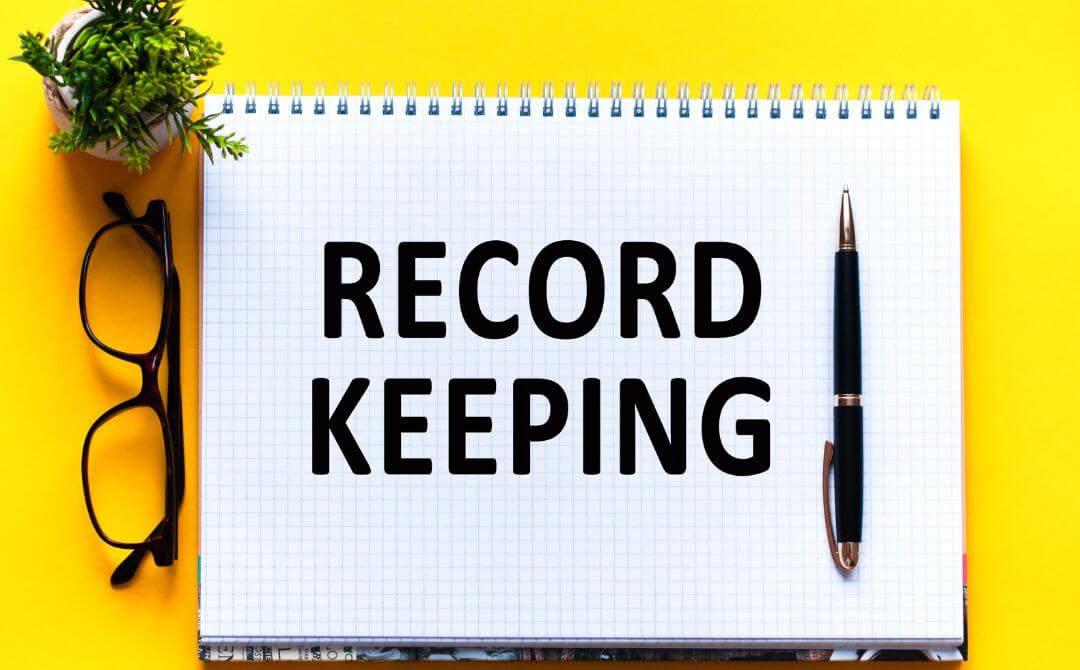Navigating the world of taxes can often feel like a labyrinth, especially for sole traders who are responsible for managing every aspect of their business. A critical element in this journey is understanding the Goods and Services Tax (GST) – a value-added tax levied on most goods and services sold for domestic consumption. But as a sole trader in Australia, the question often arises: “Do I need to register for GST?”
The Threshold For GST Registration
In Australia, GST registration is mandatory for businesses once their annual turnover (the total ordinary income) reaches or exceeds the $75,000 threshold. This rule applies universally, whether you’re a brick-and-mortar store, a digital nomad, or a tradesperson. However, for sole traders, there’s an added layer of personal consideration since your business income is essentially your personal income.

Voluntary Registration: A Strategic Choice
Interestingly, GST registration excludes those hitting the $75,000 mark. Sole traders can voluntarily opt to register for GST. This decision isn’t to be taken lightly; it requires weighing the pros and cons. On the one hand, registering allows you to claim credits for the GST included in the price of goods and services purchased for your business. On the other hand, it necessitates additional administrative work, like lodging Business Activity Statements (BAS) either monthly, quarterly, or annually.
Also Read: Can Sole Traders Have Employees?
Impact Of GST On Pricing And Cash Flow
A pivotal aspect of registering for GST is its impact on your pricing structure. As a registered entity, you must add 10% GST to your taxable sales. This change can either make your offerings seem more expensive to customers or reduce your profit margin if you decide to absorb the GST. Thus, it’s a balancing act between remaining competitive and maintaining profitability.
Navigating GST With SoleApp
In the maze of GST compliance, tools like SoleApp emerge as beacons of clarity for Australian sole traders. Developed with a keen understanding of the local business landscape, SoleApp simplifies financial management, including GST tracking and reporting. By automating aspects of the GST process, SoleApp saves time and reduces the likelihood of errors – a boon for sole traders who often juggle multiple roles in their business. Its user-friendly interface, tailored specifically for the Australian market, makes it an invaluable asset for sole traders looking to streamline their accounting processes.
Do You Have To Pay GST As A Sole Trader?
Once you’re registered for GST, it becomes a part of your regular business cycle. You must collect GST on the government’s behalf for the taxable goods and services you sell. This collection is then periodically remitted to the Australian Taxation Office (ATO) through your BAS.

Claiming GST Credits
A significant advantage of being GST-registered is the ability to claim GST credits. You can claim credits for the GST included in the price of goods and services purchased for your business. This can be a substantial financial relief, especially for businesses with high operational costs.
Also Read: How To Sell Personal Training: Expert Tips For Success
The Compliance Aspect: Reporting And Payments
Compliance is key when dealing with GST. Regular reporting through BAS is mandatory. This process involves detailing your total sales, the GST collected, and the GST credits you’re claiming. The frequency of these reports depends on your turnover and the reporting option you choose.
Understanding The GST-Free Sales
Not all goods and services are subject to GST. There are GST-free sales like certain food items, healthcare services, and educational courses. As a sole trader, understanding which of your products or services fall into this category is crucial to avoid overcharging your customers or misreporting your taxes.
Record Keeping: A Critical Practice
Maintaining meticulous records is non-negotiable for GST compliance. This includes invoices, receipts, and other financial documents. Proper record-keeping not only aids in accurate BAS lodgments but also becomes indispensable in the case of audits.

Staying Ahead With Digital Tools: The Role Of Technology In GST Management
The landscape of business management, especially in the realm of finance and taxation, has been revolutionised by digital tools. For Australian sole traders, leveraging technology is a convenience and a strategic move to ensure compliance and efficiency. Digital accounting tools, like SoleApp, have become indispensable for those looking to navigate the complexities of GST without being overwhelmed.
These tools offer a range of features – from automated GST tracking to simplified BAS lodgment processes. They allow sole traders to keep accurate records, calculate GST liabilities, and even offer insights into cash flow management. By integrating such tools into their business processes, sole traders can save considerable time and resources, which can then be redirected to core business activities.
Furthermore, the use of digital tools aligns with the Australian Taxation Office’s push towards electronic lodgment of tax-related documents. This alignment ensures compliance and streamlines interactions with tax authorities, making the entire process smoother and more transparent.
Empowering Decision-Making: Understanding GST Implications
As a sole trader, understanding the implications of GST on your business decisions is crucial. Whether it’s setting prices, planning purchases, or expanding your business, the GST factor plays a significant role. By understanding the nuances of GST, you can make more informed decisions that benefit your business financially and strategically.
Also Read: How To Become A Personal Trainer In Australia? A Detailed Guide
For instance, knowing when to claim GST credits can significantly affect your cash flow. Similarly, understanding how GST impacts your pricing strategy can help you stay competitive without compromising profitability. Additionally, understanding the GST implications on exports and international services is vital for those trading with businesses or consumers outside Australia.
Conclusion: Making An Informed Decision
Deciding whether to register for GST as a sole trader involves a careful evaluation of your business’s financial landscape and future projections. While reaching the $75,000 turnover threshold mandates registration, voluntary registration can offer benefits like GST credits. However, it’s essential to balance this with the added responsibilities and administrative tasks.
Tools like SoleApp play a pivotal role in simplifying these complexities, offering tailored solutions that resonate with the unique challenges faced by Australian sole traders. Embracing such digital solutions can transform the daunting task of GST compliance into a manageable aspect of your business, allowing you to focus more on growth and less on tax intricacies.


